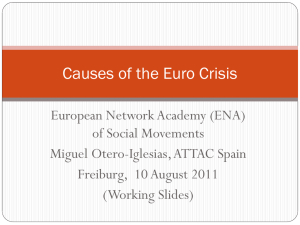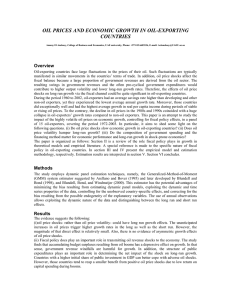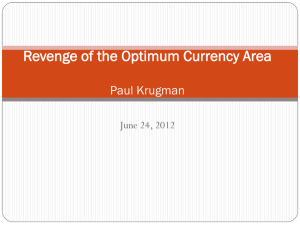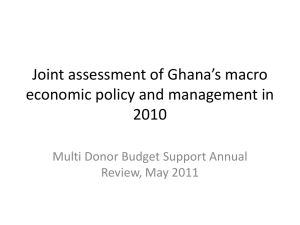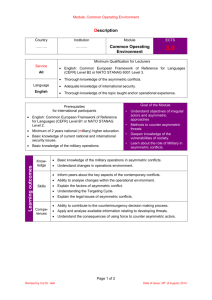Frank Barry - University College Dublin
advertisement
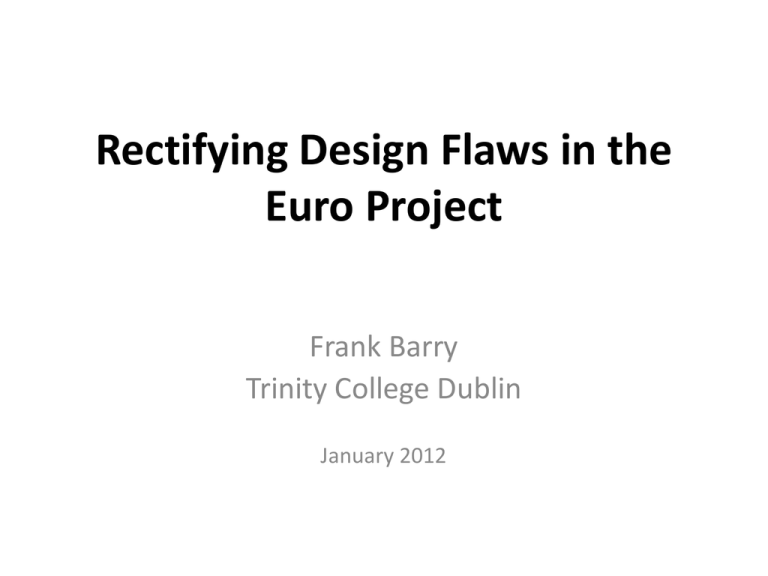
Rectifying Design Flaws in the Euro Project Frank Barry Trinity College Dublin January 2012 Design Flaws? What Design Flaws? Jean-Claude Trichet President of the European Central Bank Whitaker lecture, Dublin, May 2004 • “We Europeans have been very bold in creating a single currency in the absence of a political federation, a federal government and a federal budget for the euro area” • As long as the fiscal constraints are respected, the euro will work fine Assumption is that country-specific shocks are largely the result of divergent fiscal policies • But Optimal Currency Area literature of the 1960s pointed out that asymmetric trade and production structures mean asymmetric shocks • In Eichengreen’s work of the mid-1990s, nonpolicy-induced asymmetric shocks appeared particularly important for Ireland and the other peripheral EU12 economies (including the UK) • Easy to understand in Ireland’s case: – Important FDI links with the US – UK remains important export destination (and competitor) for labour-intensive indigenous output • Policy harmonisation will largely remove policy-induced asymmetric shocks but not other asymmetric shocks • Business cycles will remain imperfectly correlated Examples of asymmetric Irish shocks • Dramatic falls in sterling preceding the Irish devaluations of 1986 and 1993 • Even if the Irish pound had not been open to speculative attack, would the automatic fiscal stabilisers have been sufficient to cope? • If the answer is “no”, then consider what the new fiscal pact would have entailed – Would have imposed further austerity upon existing austerity • An EU Commission paper from 1997 analysed the 24 most severe recessionary episodes from the mid 1970s to mid 1990s. Five of the 24 would have led to violation of the SGP excessive deficits procedure even if countries had begun with deficits of zero But in the “German view” maybe that doesn’t matter too much! From the Dublin speech of Jean-Claude Trichet: • “I would maintain that wealth and expectational effects of well-designed consolidation programmes might very much reduce and possibly even outweigh the traditional Keynesian multiplier effects of fiscal policy on demand and activity” • “Ireland’s experience post 1987 clearly shows how policies geared to fiscal consolidation do not necessarily entail contractionary effects on real aggregate demand and economic activity” Doomsday “asymmetric shock scenario” for Ireland • Unlikely, but … • Assume – dramatic changes to US corporation tax laws on “deferral”, or – CCCTB wipes out our corporation tax base • Remember: US companies pay 40% of Irish corporation tax revenues, and these are high relative to GDP for Ireland. Bulk of revenues paid by a small number of MNCs Non-policy-induced asymmetric shocks are alleviated in the U.S. by the response of the federal budget • For every $1 by which a state’s income falls relative to the US average, the federal budget cushions up to 40c of the shock • This is the logic of where the eurozone is headed • Paul De Grauwe warned in 1999 that “failure to create a European government with similar responsibilities to present national ones creates the risk of the break-up of the monetary union” • Was referring in this case to the fiscal federalism argument just outlined, but … • Also warned that freer capital mobility would reinforce regional booms, threatening financial stability unless regulatory structures were federalised “The Euro and Financial crises”, Paul De Grauwe, 1998 • “Suppose a country, which we arbitrarily call Spain, experiences a boom which is stronger than in the rest of the euro-area. Since the ECB looks at euro-wide data, it cannot do anything to restrain it. Unhindered by exchange risk, vast amounts of capital are attracted from the rest of the euro-area. • Spanish banks that still dominate the Spanish market increase their lending, driven by the high rates of return on ever increasing Spanish asset prices, and by the fact that they can borrow funds at the same interest rate as banks in Germany. After the boom comes the bust. Asset prices collapse, creating a crisis in the Spanish banking system” • “The US monetary union provides many examples of such local booms and busts followed by financial crises that lead to large scale bail-out operations. Scenarios of local booms and bust, as the one just described, will almost certainly happen in the future euro-area. • The founders of EMU have taken extraordinary measures to reduce the risk of debt default by governments. Excessive debt accumulation by the private sector can be equally, if not more, risky. The institutions that should guard EMU from financial and banking crises have still to be put in place” Implications • Monetary union requires centralised bank regulation and resolution regimes • Existing situation, as our ‘Dr. Doom’ put it, is like expecting the taxpayers of Newcastle to bail out Northern Rock One problematic design characteristic that cannot be rectified in our favour • Under the EU, as Garret Fitz Gerald always reminded us, the Commission was the best defence of smaller member states’ interests • Commission is much less important within the eurozone


